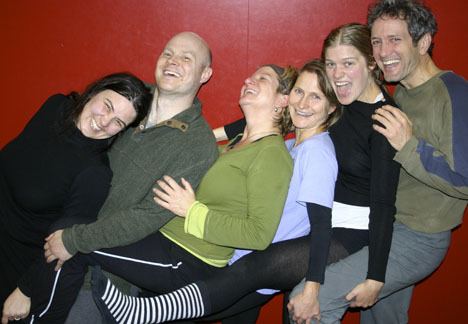It was 1989 when a bright-eyed band of six young theater artists arrived on Vashon’s shores.
The performers — Esther Edelman, Martha Enson, David Godsey, Kevin Joyce, Janet McAlpin and Steffon Moody — were eager to create their own brand of muscular, kinetic theater, and soon after settling on Vashon, they organized themselves as a cutting-edge troupe, today known as the UMO Ensemble.
“A wise woman once said to us, ‘Grow where you’re planted,'” said Godsey. “And we have been truly blessed by having Vashon as our place to grow.”
And while UMO’s arrival here happened almost by chance — Moody and Edelman suggested Vashon to the rest of the group, after the pair fell in love with the came here for an unplanned visit — what has happened with the troupe since then has been very much by design.
UMO — still Island-based, with four of its six founding members still in the group — now has 22 full-length productions to its credit, not to mention a rich history of appearances on stages throughout the Northwest and beyond.
This weekend, the ensemble will celebrate the milestone of its 20th anniversary on Vashon by restaging one of its seminal works, “El Dorado.”
Created in 1992 in UMO’s trademark style of “buffoon theatre,” the play focuses on the Spanish conquistadors search for the legendary Kingdom of Gold in the Americas.
It’s a comedic and high-energy theater piece that has received acclaim around the world, with one London critic calling it “simply masterful.”
According to McAlpin, who is directing the remount, the message of the play still resonates.
“’El Dorado’ is still artistically and socially relevant 17 years later,” she said, noting that the play still addresses “our nagging quest for more, better, bigger stuff.”
McAlpin noted this weekend’s anniversary production would include some recasting, restaging and updating of the piece, though it will boast what she called “wonderfully grotesque” original costumes designed by long-time UMO collaborator Patricia Toovey.
In recent years, the ensemble has grown to include new members, including Amy Rider, Lyam White, Kajsa Ingemansson and Mik Kulhman.
Another relative newcomer to UMO’s ensemble, Elizabeth Klob, serves as UMO’s executive artist, a post she’s held for the past four years and that has placed her in the pivotal role of overseeing the group’s artistic endeavors.
The group’s output has ebbed and flowed in the last decade, due in no small part to a baby boom that occurred within the group between 2001 and 2003. During that time span, ensemble members gave birth to five children.
“Some people think we planned to all have our children within one and a half years,” McAlpin joked.
And while not all the original members are still a part of the group — Joyce, Moody and Abby Enson have moved on to other pursuits — everyone who arrived with the original group in 1989 still lives on the Island.
“The original group has a strong familial identity,” Moody said. “It’s a way of life, sort of like being a gypsy.”
Moody, who said he has “undying gratitude” for his years with the ensemble, believes that in the past 20 years, UMO has helped shape the culture of the Island.
He pointed to the Backbone Campaign’s giant puppet imagery, as well as the annual festival Islewilde, as direct examples of UMO’s influence.
“We had a whole different style and energy,” Moody said, defining the group’s artistic mode as “Euro-clowning, Bread & Puppet theater and commedia del arte.”
Looking to the future, McAlpin said the ensemble’s vision is still evolving.
“We have completed all the artistic ideas from the original founding members, and now it is time for the new ensemble members to give the spark of life to their creative visions in a new configuration of the ensemble,” she said.
Klob agreed.
“Just from an artistic standpoint, I think we’re really in a new and exciting place,” she said. “We’re all standing on the precipice — what are we going to do next?”
The origin of the name is something people have often asked about. UMO members say it’s really not a very interesting story: They came up with the name Unidentified Moving Objects Inc and “picked it for the acronym,” McAlpin said. “We wanted a name that evoked something that was not defined and that would come to be defined by what we did. Hence the acronym UMO.”
That acronym — both vague and evocative — continues to define the group, as it has for the past 20 years.
Whatever the group chooses to do, it is sure to be informed by its 20-year history on Vashon.
“Something about the Island has been very nurturing to UMO,” said McAlpin, who recalled how the group spent 17 years rehearsing in the now demolished old elementary school gym building.
“It’s like Virginia Woolf said — to have a space to create is essential.”
UMO’s new rehearsal and performance space is Open Space for Arts & Community, a converted warehouse McAlpin and Godsey have developed independent of their association with UMO.
And McAlpin, for her part, seems no less enthusiastic about UMO’s future than she was 20 years ago.
She described an epiphany she experienced when she began to design a T-shirt to commemorate the group’s upcoming anniversary.
“I was thinking what would go on it, and imagining the words ‘UMO celebrates 20 years’ in print, and I felt very proud to be a part of something that still exists,” McAlpin said. “I was reflecting on how many arts organizations we know and love in Seattle are no longer with us, and I was feeling very lucky to be a part of something that is still alive and kicking and thriving.”
UMO will perform “El Dorado” at 8 p.m. Friday and Saturday, Nov. 13 and 14, at Open Space for Arts & Community. Tickets are $15 in advance and $20 at the door and are available at Books by the Way, Vashon Bookshop and online at www.brownpapertickets.com.


